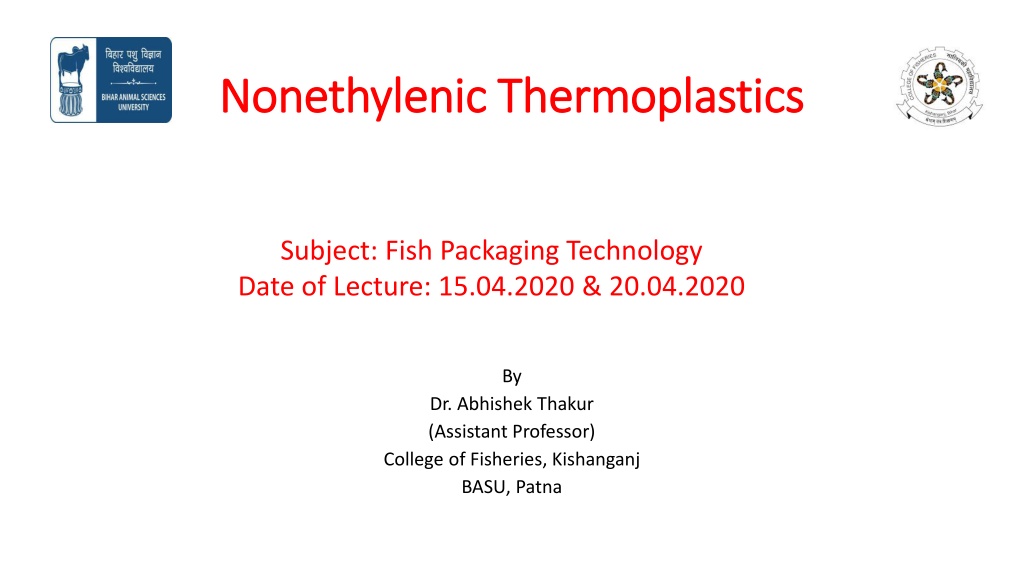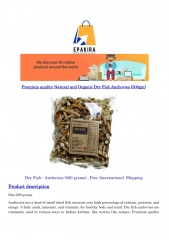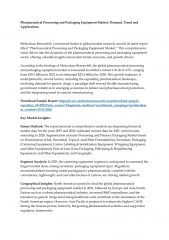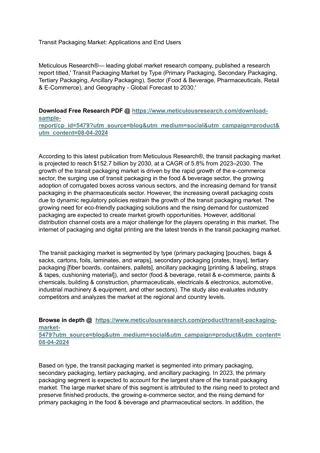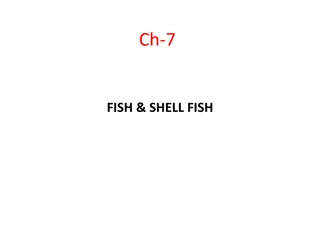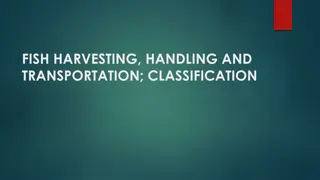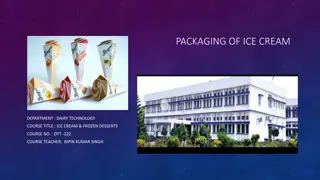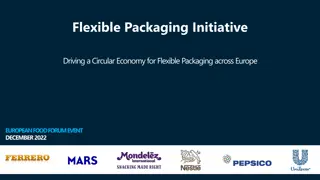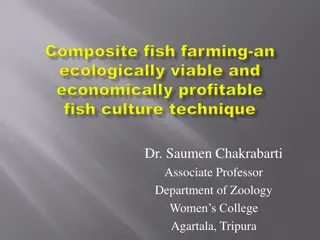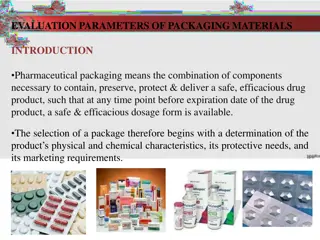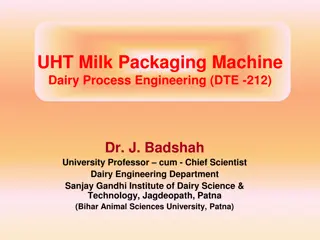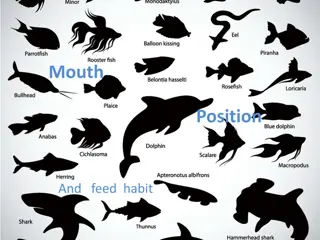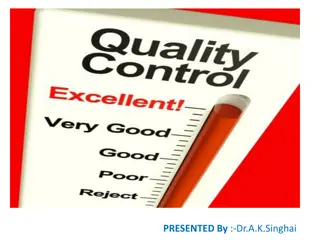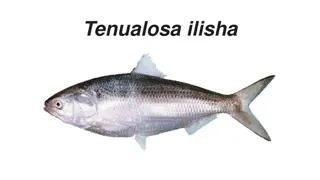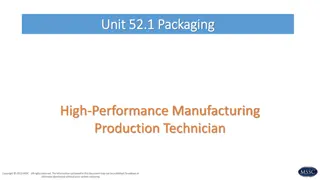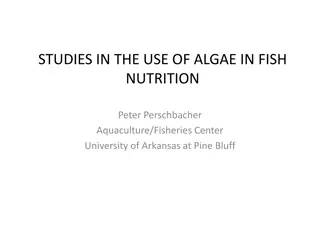Fish Packaging Technology Overview
Explore the use of nonethylenic thermoplastics like polyamides or nylons in fish packaging technology, citing examples such as Nylon 6, Nylon 6:6, and Nylon 6:10. Learn about their important properties, applications in gas/vacuum packaging and boil-in-bag pouches, as well as the benefits of combining polyamides with LDPE or HDPE. Discover the features of polycarbonates, rubber hydrochlorides, and regenerated cellulose film in enhancing packaging solutions for fish products.
Uploaded on Nov 20, 2024 | 0 Views
Download Presentation

Please find below an Image/Link to download the presentation.
The content on the website is provided AS IS for your information and personal use only. It may not be sold, licensed, or shared on other websites without obtaining consent from the author.If you encounter any issues during the download, it is possible that the publisher has removed the file from their server.
You are allowed to download the files provided on this website for personal or commercial use, subject to the condition that they are used lawfully. All files are the property of their respective owners.
The content on the website is provided AS IS for your information and personal use only. It may not be sold, licensed, or shared on other websites without obtaining consent from the author.
E N D
Presentation Transcript
Nonethylenic Nonethylenic Thermoplastics Thermoplastics Subject: Fish Packaging Technology Date of Lecture: 15.04.2020 & 20.04.2020 By Dr. Abhishek Thakur (Assistant Professor) College of Fisheries, Kishanganj BASU, Patna
Polyamides or Nylons Nylons are prepared by the condensation of diamines with diacids and are designated by the number of carbon atoms in the reactant molecules. For example, Nylon 6:6 (Nylon 6) (Adipic acid & hexamethylene diamine) and is easy to handle and is abrasion resistant Nylon 6:10 (Nylon-10) Nylon 6:11 (Nylon 11), Nylon 6:12 (Nylon 12) have superior barrier properties against oxygen and water and have lower heat seal temperatures. Nylon- 66 high MP and hence difficult to heat seal.
Polyamides or Nylons Important properties of Nylon High oil and grease residence (Polar nature) Low oxygen permeability Excellent strength Resistant to caustic alkalis and organic solvents such as alcohols, ether, benzene xylene, carbon tetrachloride, acetone and many mineral oils. High melting point.
Polyamides or Nylons Polyamide/ LDPE or Polyamide / HDPE combine barrier properties of polyamide and heat sealing characteristics of PE. Such laminates are used for gas or vacuum packaging of fish. They are also used in the fabrication of boil in bag or retortable pouch packaging. Nylon is rather expensive.
Polycarbonates Polycarbonates are linear polyesters of carbonic acid with aliphatic or aromatic dihydroxy compounds & are readily soluble in chlorinated hydrocarbon. Films are heat sellable & have excellent clarity. They have high impact resistance & good temperature resistance. They are resistance to weak acids & alkalies. Permeability to gas & water vapour is poor.
Rubber Hydrochlorides Produced from natural rubber by treatment with hydrochloric acid. It can be stretched, heat sealable, non-toxic, resistance to oils and greases. Unaffected by acids or alkalis & does not support combinations. On storage it may become discoloured and brittle.
Regenerated cellulose film Cellulose is obtained from wood pulp or cotton linters. It is soaked in caustic soda for about an hour and the recess alkali is pressed out. Residue is pressed and allowed to age for 2-3 days during which time it absorbs oxygen from air and reduces the chain length of cellulose. It is dissolved in carbon disulphide solution and then dispersed in dilute alkali.
Regenerated cellulose film Each film designated using codes: Though varying quality cellulose acetate has been prepared, a great deal of standardization has been done and each type film is designated by using codes as follows. P Basic films non moisture proof and Non heat sealable. M Nitrocellulose coated on both sides moisture proof. S Heat sealable. MS Heat sealable, moisture proof. QM Nitrocellulose coated on both sides but less moisture proof than QM, PS Nitrocellulose coated on both sides but less moisture proof than GM. DM Nitrocellulose coated on our side. MXXT/A- PVDC coated our both sides by aqueous dispersion MXXT/5 PVDC copolymer coated by solvent process on both sides. B Opaque C Coloured Name of the colour follows F for twist wrap.
Copolymers The polymers discussed above are all made from single monomer each & are known as hompolymers. In some cases polymers are prepared by the additive reaction of more than one polymers or by condensation of different polymers. These products are known as copolymers. The properties will depend not only on the composition of the monomers used, but also on their arrangement in the chain. Ex.Food packaging Ethylene Vinyl Acetate Vinyl Chloride copolymers Polypropylene copolymers Polystyrene copolymers
Ethylene Vinyl Acetate EVA copolymers are made by copolymerisation of LDPE with vinyl acetate. They contain upto 20% Vinyl acetate. EVA are more flexible than LDPE but have higher permeability to gases & water vapour. EVA s are thermally unstable at high temperatures, but are very stable at lower temperatures & have wide heat seal range.
Vinyl Chloride copolymers Copolymerised with vinyl acetate, PP & acrylonitrite. Vinyl chloride copolymers have better flow properties simultaneously remaining tough. Vinyl chloride/vinylidine chloride copolymers have low water vapour & gas permeability. Used to improve the barrier properties of paper,PP & Cellulose films.
Polypropylene copolymers PP-ethylene copolymers are hazy due to light scattering. PP copolymers have lower MP & have improved low temperature impact strength.
Polystyrene copolymers Copolymers of polystyrene, acrylonitrile & butadiene are rigid & posses high impact properties. High nitrile resins have excellent gas barrier properties as well.
Ionomers Ionomers are essentially LDPE, where in ionic forces due to carbonyl ions containing metallic ions such as sodium or Zinc are introduced. Ionomers are more resistant to oils & fats, superior in transperancy, toughness, abrasion resistance & coating addition. They are specially used in skin packaging, meat packaging & in combination with polyamides for packaging oils and fats.
Laminates None of the polymers posses all the desirable properties for all food products. So, the packaging requirements are often met with employing several polymers or using other types of materials like Al or paper or their combinations. Such combinations are called laminates. Consists of layers of individual materials on top each other & are bonded together with the help of adhesive. Laminates containing all plastics materials can also be produced as a composite films by co-extrusion or coating.
Other constituents of plastics Plastics are high Mol.wt. products & do not get transferred to the food. Some substances are added during the manufacture of plastics to assist the production process or to enhance the mechanical and other properties & stability of the final products. These are anti-oxidants, anti-block agents, heat & light stabilizers, pasticiser, pigments, filler, fungicides etc. Qty. varied & may migrate to food & possibility of such low mol. Wt. products is of great concern with a food packaging material.
Another sources of substances other than the basic polymers in plastics is its polymerisation residues, including monomers, catalyst, solvents etc. The volatile monomers like ethylene may lost during storage whereas styrene are difficult to remove. Food grade chemicals should be used.
Migration of constituents Transfer of substances from the package, (generally a plastic material), to the food or from food to package. Monomers & processing additives polymerisation. Migration of constituents of the packaging to the food is of great concern and many of migrants may be toxic to humans. or other residues of
Toxicological aspects of Food Packaging Toxicity in food caused by the packaging materials results from the migration of toxic substances while in contact with food. Chemical substances added to the packaging for attaining better functional properties may be toxic to humans. Vinyl chloride monomers have been associated with lesion of the bones in terminal joints of the fingers & toes as well as change in the liver & spleen of human being. Long term exposure leads to a rare form of liver cancer.
Toxicological aspects of Food Packaging Vinylidine chloride has been found to affect the activity of several rat liver enzymes & decreases the stores of glutathione. Acrylonitrile is more toxic than chlorinated monomers and is associated with carcinogenicity in animals and humans. Styrene & its oxide have been incriminated against chromosomal aberration in certain conditions. Toxicity & carcinogenicity associated with monomers are well established, whereas no such evidence against the polymers. By Improved technology, the presence of monomers in final product is reduced.
